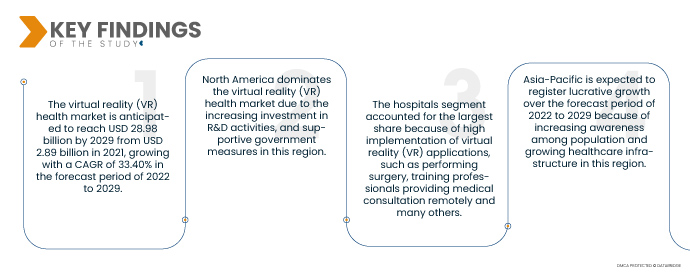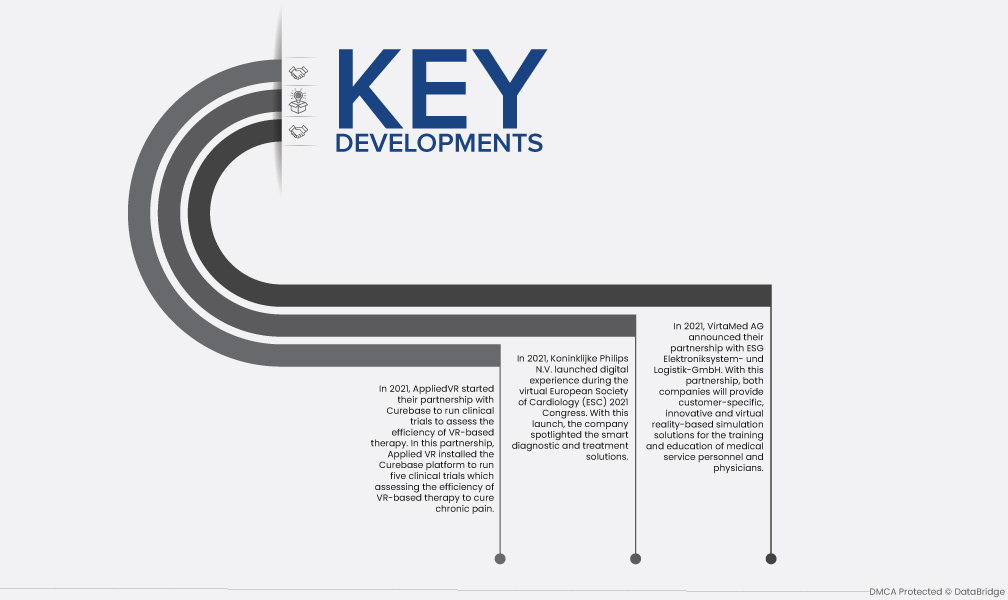Спрос на виртуальную реальность (VR) в здравоохранении продолжал расти в последние несколько лет. Число людей, активно использующих виртуальную реальность (VR) для многочисленных приложений, резко возросло. Виртуальная реальность (VR) имеет множество приложений для здравоохранения, от клинических до потребительских. Таким образом, растущее принятие виртуальной реальности (VR) в многочисленных приложениях, таких как лечение пациентов, хирургия, стоматология, физиотерапия, медицинское обучение, лечение боли, реабилитация и другие, является основным фактором роста рынка.
Доступ к полному отчету по адресу https://www.databridgemarketresearch.com/reports/global-virtual-reality-vr-health-market
По данным исследования рынка Data Bridge, ожидается, что рынок виртуальной реальности (VR) в здравоохранении достигнет 28,98 млрд долларов США к 2029 году по сравнению с 2,89 млрд долларов США в 2021 году, а среднегодовой темп роста составит 33,40% в прогнозируемый период с 2022 по 2029 год. Увеличение числа пользователей смартфонов в организациях и растущее проникновение интернет-услуг откроют потенциальные возможности для роста рынка в прогнозируемый период.

Ожидается , что усиление государственных инициатив по обеспечению безопасности пищевых продуктов будет способствовать росту рынка.
Виртуальная реальность (VR) — это передовая технология, которая позволяет пользователю моделировать интересующий опыт или ситуацию. Технология виртуальной реальности (VR) используется в различных областях здравоохранения в различных приложениях. К ним относятся медицинское обучение врачей и студентов, медицинский маркетинг, лечение пациентов и обучение людей о медицинском состоянии или процессе. Эта технология обеспечивает иммерсивную среду, которая позволяет пользователям иметь измененный опыт реальности. Виртуальная реальность все чаще используется для лечения пациентов с неврологической дисфункцией, тревогой, болью, инвалидностью, ожирением и депрессией. Поэтому ожидается, что рост внедрения таких инновационных технологий, которые предоставляют передовые решения для услуг по уходу в реальном времени и лучшего управления уходом, увеличит рост рынка в ближайшие годы.
Область отчета и сегментация рынка
Отчет Метрика
|
Подробности
|
Прогнозируемый период
|
2022-2029
|
Базовый год
|
2021
|
Исторические годы
|
2020 (Можно настроить на 2015 - 2020)
|
Количественные единицы
|
Доход в млн. долл. США, объемы в единицах, цены в долл. США
|
Охваченные сегменты
|
Продукт (оборудование, программное обеспечение и услуги), технология (технология крепления на голове, технология отслеживания жестов, технология проекторов и видеостен, на основе мобильных устройств и другие), приложение (медицинское обучение и образование, терапия с использованием виртуальной реальности, хирургия, управление уходом за пациентами, реабилитация, управление болью и другие), терапевтическая область (черепно-лицевая, сердечно-сосудистая, офтальмология, пульмонология, неврология, расстройства сна, фобии, зависимости, посттравматическое стрессовое расстройство (ПТСР) и другие), конечный пользователь (больницы, клиники, хирургические центры, амбулаторные хирургические центры, диагностические центры, реабилитационные центры, учреждения долгосрочного ухода, психиатрические учреждения и другие), канал распространения (прямые тендеры, розничные продажи и сторонние дистрибьюторы)
|
Страны, охваченные
|
США, Канада и Мексика в Северной Америке, Германия, Франция, Великобритания, Нидерланды, Швейцария, Бельгия, Россия, Италия, Испания, Турция, Остальная Европа в Европе, Китай, Япония, Индия, Южная Корея, Сингапур, Малайзия, Австралия, Таиланд, Индонезия, Филиппины, Остальная часть Азиатско-Тихоокеанского региона (APAC) в Азиатско-Тихоокеанском регионе (APAC), Саудовская Аравия, ОАЭ, Южная Африка, Египет, Израиль, Остальной Ближний Восток и Африка (MEA) как часть Ближнего Востока и Африки (MEA), Бразилия, Аргентина и Остальная часть Южной Америки как часть Южной Америки.
|
Охваченные участники рынка
|
Siemens (Германия), Virtalis (Великобритания), CAE Healthcare (США), General Electric (США), Virtual Realities LLC (Великобритания), Qualcomm Technologies Inc. (США), Samsung (Южная Корея), Vuzix (США), Mimic Technologies Inc (США), Brainlab AG (Германия), SAMSUNG (Южная Корея), Brainlab AG, Firsthand (США), ImmersiveTouch, Inc (США), Koninklijke Philips NV (Нидерланды), Medical Realities Ltd (Великобритания), PSICO SMART APPS, SL (Испания), SimX (Канада)
|
Данные, отраженные в отчете
|
Помимо таких рыночных данных, как рыночная стоимость, темпы роста, сегменты рынка, географический охват, участники рынка и рыночный сценарий, рыночный отчет, подготовленный командой Data Bridge Market Research, включает в себя углубленный экспертный анализ, анализ импорта/экспорта, анализ цен, анализ потребления продукции и анализ пестицидов.
|
Анализ сегмента:
Рынок виртуальной реальности (VR) в здравоохранении сегментирован по признаку продукта, технологии, сферы применения, терапевтической области, конечного пользователя и канала сбыта.
- По продуктовому признаку глобальный рынок виртуальной реальности (VR) в здравоохранении сегментирован на оборудование, программное обеспечение и услуги.
Ожидается, что сегмент оборудования и продуктов будет доминировать на рынке виртуальной реальности (VR) в здравоохранении.
Ожидается, что на мировом рынке виртуальной реальности (VR) в здравоохранении будет доминировать оборудование с долей рынка 51,55% из-за широкого распространения продуктов виртуальной реальности (VR), таких как очки и гарнитуры, высокой стоимости аппаратных продуктов по сравнению с услугами и программным обеспечением, а также широкого внедрения устройств виртуальной реальности (VR) в больницах.
- На основе технологий глобальный рынок виртуальной реальности (VR) в здравоохранении был сегментирован на технологию с креплением на голове, технологию отслеживания жестов, технологию проекторов и видеостен, на основе мобильных устройств и др. Ожидается, что технология с креплением на голове будет доминировать на мировом рынке виртуальной реальности (VR) в здравоохранении с долей рынка 51,24% из-за растущих инвестиций в эту технологию, улучшения коммуникации между врачами и поощрения их к принятию правильных решений относительно лечения и здоровья пациента.
- На основе сферы применения глобальный рынок виртуальной реальности (VR) в здравоохранении сегментирован на следующие сферы: медицинское обучение и образование, терапия с использованием виртуальной реальности, хирургия, управление уходом за пациентами, реабилитация, лечение боли и другие.
Ожидается, что сегмент медицинского обучения и образования в прикладном сегменте будет доминировать на рынке виртуальной реальности (VR) в здравоохранении.
Ожидается, что медицинское обучение и образование будут доминировать на мировом рынке виртуальной реальности (VR) в здравоохранении с долей рынка 30,27% из-за широкого использования продуктов виртуальной реальности (VR) в медицинском образовании и создания трехмерной среды обучения, которая еще больше способствует улучшению человеческого взаимодействия.
- На основе терапевтической области глобальный рынок виртуальной реальности (VR) в здравоохранении был сегментирован на краниофациальный, сердечно-сосудистый, офтальмологический, легочный, неврологический, расстройства сна, фобии, зависимости, посттравматическое стрессовое расстройство (ПТСР) и другие. Ожидается, что посттравматическое стрессовое расстройство (ПТСР) будет доминировать на мировом рынке виртуальной реальности (VR) в здравоохранении с долей рынка 31,68% из-за всплеска использования виртуальной реальности (VR) для лечения ПТСР и снижения тяжести симптомов.
- На основе конечного пользователя глобальный рынок виртуальной реальности (VR) в здравоохранении сегментирован на больницы, клиники, хирургические центры, амбулаторные хирургические центры, диагностические центры, реабилитационные центры, учреждения долгосрочного ухода, психиатрические учреждения и т. д. Ожидается, что больницы будут доминировать на мировом рынке виртуальной реальности (VR) в здравоохранении с долей рынка 41,68% из-за высокой степени внедрения приложений виртуальной реальности (VR), таких как проведение хирургических операций, обучение специалистов, предоставление медицинских консультаций удаленно и многое другое.
- На основе канала распространения глобальный рынок виртуальной реальности (VR) в здравоохранении был сегментирован на прямые тендеры, розничные продажи и сторонних дистрибьюторов. Ожидается, что розничные продажи будут доминировать на мировом рынке виртуальной реальности (VR) в здравоохранении с долей рынка 70,23%, поскольку хирургические центры, больницы и другие конечные пользователи устанавливают сотрудничество, партнерства и соглашения для внедрения продуктов виртуальной реальности (VR) в своих медицинских учреждениях.
Основные игроки
Компания Data Bridge Market Research выделяет следующие компании в качестве основных игроков на рынке виртуальной реальности (VR) в здравоохранении: Siemens (Германия), Virtalis (Великобритания), CAE Healthcare (США), General Electric (США), Virtual Realities LLC (Великобритания), Qualcomm Technologies Inc. (США), Samsung (Южная Корея), Vuzix (США), Mimic Technologies Inc (США), Brainlab AG (Германия), SAMSUNG (Южная Корея).
Развитие рынка

- В 2021 году AppliedVR начала партнерство с Curebase для проведения клинических испытаний по оценке эффективности терапии на основе VR. В рамках этого партнерства Applied VR установила платформу Curebase для проведения пяти клинических испытаний по оценке эффективности терапии на основе VR для лечения хронической боли. Это помогло компании развиться на рынке.
- В 2021 году компания Koninklijke Philips NV запустила цифровой опыт во время виртуального конгресса Европейского общества кардиологов (ESC) 2021. С этим запуском компания выделила умные диагностические и лечебные решения. Это поможет компании улучшить свои предложения и расширить свое присутствие на рынке.
- В 2021 году VirtaMed AG объявила о партнерстве с ESG Elektroniksystem- und Logistik-GmbH. Благодаря этому партнерству обе компании будут предоставлять индивидуальные, инновационные и основанные на виртуальной реальности решения для моделирования обучения и воспитания медицинского персонала и врачей. Это поможет компании увеличить продажи и расширить свое присутствие на рынке.
Региональный анализ
Географически страны, охваченные отчетом о рынке виртуальной реальности (VR) в здравоохранении, следующие:
США, Канада и Мексика в Северной Америке, Германия, Франция, Великобритания, Нидерланды, Швейцария, Бельгия, Россия, Италия, Испания, Турция, Остальная Европа в Европе, Китай, Япония, Индия, Южная Корея, Сингапур, Малайзия, Австралия, Таиланд, Индонезия, Филиппины, Остальная часть Азиатско-Тихоокеанского региона (APAC) в Азиатско-Тихоокеанском регионе (APAC), Саудовская Аравия, ОАЭ, Южная Африка, Египет, Израиль, Остальной Ближний Восток и Африка (MEA) как часть Ближнего Востока и Африки (MEA), Бразилия, Аргентина и Остальная часть Южной Америки как часть Южной Америки.
Согласно анализу Data Bridge Market Research:
Европа будет доминирующим регионом на рынке виртуальной реальности (VR) в здравоохранении в прогнозируемый период с 2022 по 2029 год.
Северная Америка доминирует на рынке виртуальной реальности (VR) здравоохранения из-за растущих инвестиций в научно-исследовательскую деятельность и поддерживающих мер правительства в этом регионе. Кроме того, растущее давление на основных плательщиков рынка и поставщиков медицинских услуг с целью снижения стоимости лечения будет и дальше стимулировать рост рынка виртуальной реальности (VR) здравоохранения.
По оценкам, Азиатско-Тихоокеанский регион станет самым быстрорастущим регионом на рынке виртуальной реальности (VR) в здравоохранении в прогнозируемый период с 2022 по 2029 год.
Ожидается, что Азиатско-Тихоокеанский регион будет расти в прогнозируемый период 2022-2030 гг. в связи с ростом осведомленности населения и растущей инфраструктурой здравоохранения в этом регионе. Кроме того, ожидается, что растущее распространение технологий AR и VR в секторе здравоохранения будет способствовать темпам роста рынка в этом регионе.
Для получения более подробной информации об отчете о рынке виртуальной реальности (VR) в здравоохранении нажмите здесь – https://www.databridgemarketresearch.com/reports/global-virtual-reality-vr-health-market










